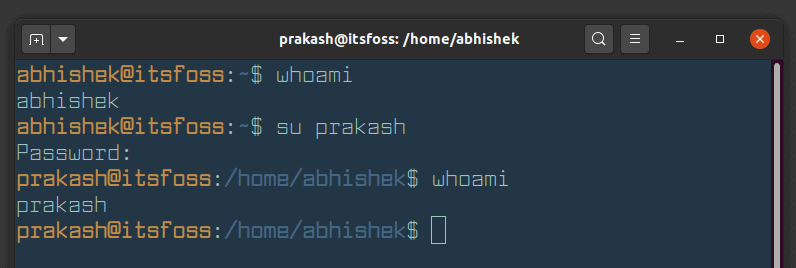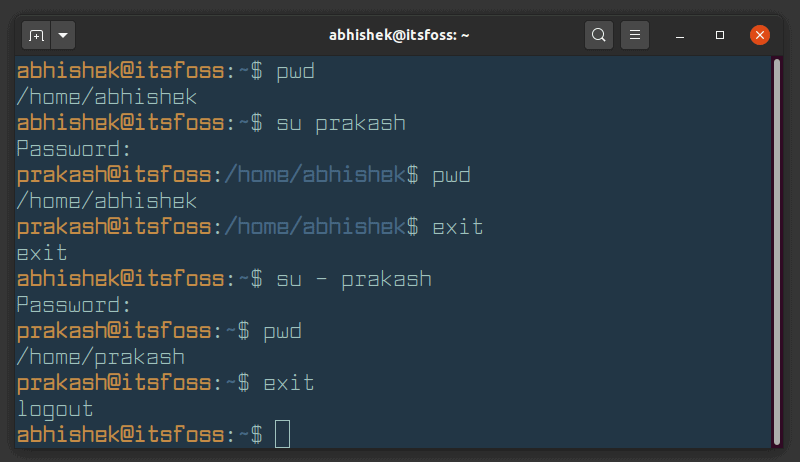- How to Change Users in Linux Command Line
- Various user types in Linux
- 1. System Users
- 2. Regular Users
- 3. Super Users
- Switch users in the command line
- Switch to root user
- How to Switch Users in Ubuntu and Other Linux Distributions [Quick Beginner Tip]
- Change user in Linux command line
- Change users in Linux graphically (for desktop Linux)
- How to Switch User in Linux [Linux Change User]
- What is SU command? [ Switch User Linux ]
- SU Command Syntax
- SU Command Options
- How to Switch User in Linux ? [C hange User Linux ]
- Change Linux user to an Another User
- As a Different User, Execute a Specific Command
- Switching to a Different Shell Environment
- In the Same Environment, Use a Different User
- Conclusion
How to Change Users in Linux Command Line
Linux systems have different users and different types of users. Learn how to switch the users in Linux command line or how to change to the root user in Linux.
Linux systems have different types of users with different types or permissions as well.
Not all users can execute all commands and not all users are allowed to switch to other users neither. This all might sound confusing but, I will try to explain these so it can be easy to understand.
For the moment, here’s a quick summary of how to switch users in Linux command line.
To switch users, you need to know the password of that user. You can switch the users with this command:
To switch to root user in Ubuntu, you can use this command:
Various user types in Linux
If you list all users in Linux, you’ll see a lot of users that you didn’t know about. Who are these users? Where did they come from? I could write an entire article in regards of how users work in Linux, however, this is not the idea for this one.
Basically, there are 3 types of users in Linux:
1. System Users
These are the users that are automatically created in Linux systems to be able to run services or applications and are not intended to log in to the system (in fact you can’t log in as any of these users).
2. Regular Users
These are the (human) users who can log in to a system. Each of these users might have or not different permissions or levels in the system which is given by the groups they belong to.
3. Super Users
These are system administrators or users who can perform high-level tasks that can be considered critical or system dangerous.
Switch users in the command line
When using a Linux system you can log in with a user and then simply “switch” to another user through the same command line session. In order to do this, there is a command “su -“, which allows you to switch to become another user:
[email protected]:~$ su - janedoe Password: [email protected]:~$ In the above example, you need to know the password of janedoe in order to switch to that user. Which makes sense because if you are going to switch to a user, you need to know the password of that user else it will be a security risk.
Switch to root user
For security reasons, some systems have ‘root’ account blocked for direct login, either locally or remotely, so this means it will not accept someone who tries to log in using ‘root’ even with the correct password.
So, how do you perform actions as the ‘root’ user? That’s what the ‘sudo’ command allows you to.
The sudo command will basically execute anything you want in the system as if the ‘root’ was doing it. You don’t need to know the ‘root’ user’s password, in fact, probably nobody knows it or there is no password assigned to ‘root’. You only need to know your own user’s password and that user must be in the ‘sudoers’ group, which is basically the group of users which can use ‘sudo’ in the system.
Normally, it is a good practice to run the commands with sudo that needs to run with root permission like this:
But if you want to change to root user so that all the subsequent commands will be run as root, you can use:
You’ll use your own password here, not the root account’s password.
As a sudo user yourself, you can create sudo user by adding the user to sudo group.
Linux systems allow you to easily switch users or execute high-level commands with the usage of ‘su‘ and ‘sudo’ commands. And remember: with great sudo power comes great responsibility!
How to Switch Users in Ubuntu and Other Linux Distributions [Quick Beginner Tip]
It is really simple to switch users in Ubuntu or any other Linux distribution using the terminal.
All you need to do is to know the unsername and its account password and you can switch users with su command:
You’ll be asked to enter the password of the user you want to switch to.
As you can see in the screenshot above, I changed to user prakash from user abhishek in the terminal.
There are some minor details with this method that I’ll share with you in a moment. I’ll also share the graphical way of switching users in Linux if you are using desktop Linux.
If you want to switch to the root user in Ubuntu, you can use the following command:
sudo su
You’ll have to enter your own user password here.
Change user in Linux command line
Let’s see things a bit in detail. To switch users, you need to first know the exact username because tab competition doesn’t work here. You can list all the users in Linux command line by viewing the content of the /etc/passwd file.
You’ll also need to know the password of the user account you want to switch to. This is for security reason, of course.
If you are the admin user or have sudo access, you can change account password with passwd command.
You’ll notice that some people use a — between su and the username. There is a specific reason for that.
When you use -, -l or –login option, you start the shell as a login shell. This means that it will initialize the environment variables like PATH and changes to the home directory of the changed user. It will be as if you logged into the terminal as the second user.
Note: though — is more popular, it is advised to use –login option.
Change users in Linux graphically (for desktop Linux)
If you are using desktop Linux, the above method may not be sufficient for you. Why? Because you switch the user in the terminal only. It is confined to the terminal. Nothing is changed outside the terminal.
If you want to switch users so that you can log in as another user and use all the system (browser, applications etc) graphically, you’ll have to log out and then log back in.
Now the screenshots may look different but the steps remain the same. Here’s how to switch users in Ubuntu Linux.
Go to the top right corner and click the Power Off/Log out option to open the dropdown and you can choose either of Switch User or Log Out.
- Switch User: You get to keep your session active (applications keep on running) for current user. Good for temporarily switching users as you won’t lose your work.
- Log out: Current session ends (all applications are closed). Good when you want to switch to the other user for a long time.
You can choose whichever option is more suited for your need.
Now, you’ll be at the login screen with all the available users for your system. Choose the user account of your choice.
Clearly, you need to know the password of the user account you want to use.
That’s it. I hope you find this quick beginner tip helpful in changing users in Ubuntu and other Linux distributions. Questions and suggestions are always welcome.
How to Switch User in Linux [Linux Change User]
How do I switch user in Linux? What is the su command? How does it differ from sudo? If you ever had these questions, you are in the right place.
List of content you will read in this article:
Linux has a unique and different way of switching users than other operating systems have. To switch or change user in Linux, simply input the command «su newuser», ensuring to replace «newuser» with the username of the account you wish to switch to. If you’re new to Linux, you may wonder how to switch users in Linux from the command line. The «su» command is a simple way to change which user you are logged in as. In this article, we’ll show you how to use the su command for linux change user .
To linux switch user , simply type «su» followed by the username of the user you want to switch to. For example, if you wanted to switch to the user «mvm», you would type:
You will then be prompted for that user’s password. Once entered, you will be logged in as that user.
If you want to switch users temporarily, you can use the «-l» option. This stands for «login shell.» It will give you a full login shell for the specified user. For example:
This is useful if you need to run a command as another user and don’t want to leave your current session. Remember that when using the «-l» option, you will need to enter the password for the other user twice (once for su and once for login).
What is SU command? [ Switch User Linux ]
Su allows you to change the existing user to some other user. Use the –l [username] method to define a user account if you need to execute a command as someone other than root. Switching between shell interpreters on one go is also possible using the su command. Su is a more powerful but older command. It can mimic sudo’s features by passing a single command to the shell with the –c option.
The su command in Linux is short for «substitute user or switch user» and allows a user to gain temporary access to another user’s account. This can be useful if you need to run a command as another user or troubleshoot an issue and need to access another user’s account.
SU Command Syntax
To use the su command, type the following into the command prompt:
su [options] [username [arguments]]
su defaults to the superuser if no username is specified (root). Locate the required user and include it in the su command syntax.
SU Command Options
Use -h to see a list of commands options in su:
You can use the su command with the following options:
- Username – Change your username with the username you’d like to use to log in. Any consumer, not just root, can do this.
- –command or –c [cmd] – Executes a command as the user-defined.
- –login or –l [username] – Changes the username by running a login script. For that person, you are required to enter a password.
- –s or –shell [shell] – Allows you to execute the command in a separate shell context.
- –h or –help – Displays the su command’s help file.
- –p or ––preserve-environment – Protect the shell environment (HOME, SHELL, USER, LOGNAME).
Linux VPS
How to Switch User in Linux ? [C hange User Linux ]
Change Linux user to an Another User
Enter the following command to change user Linux in this terminal window:
A password would be needed. When you type it in, the username will be changed to that account.
As a Different User, Execute a Specific Command
Using the –c alternative to execute a particular command as a separate user:
su –c [command] [other_user_name]
The system would then prompt you for your username. When you execute this command, the system will run the ls (list the directory contents) command for the defined account.
Switching to a Different Shell Environment
Enter the following to use a new shell or operating environment:
In Z shell, this command creates a root user account.
In the Same Environment, Use a Different User
With the –p alternative, you can hold the current user account’s environment:
[another user] can be replaced with the real username you choose to use. The user account will change, but your home directory will remain the same. This is helpful if you execute a command as a new user but need access to the current user’s files.
Use the echo $HOME command to show the directory you’re operating in to ensure you’re still in the same home environment.
Conclusion
In conclusion, the SU command is a powerful tool that can be used to switch users in Linux. This article has provided a comprehensive guide on using Linux change user command and some useful tips and tricks. We hope that you have found this information helpful and that you can now use the SU command confidently.





![How to Switch User in Linux [Linux Change User]](https://monovm.com/wp-content/uploads/2021/05/cover955-main.webp)